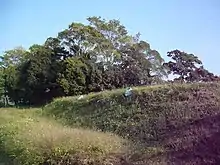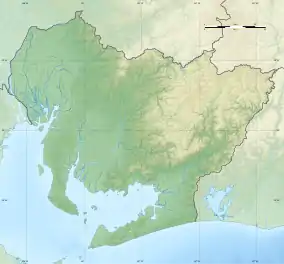Magoshi-Nagahizuka Kofun
The Magoshi-Nagahizuka Kofun (馬越長火塚古墳群) is a large Kofun period keyhole-shaped burial mound located in what is now part of the city of Toyohashi, Aichi in the Tōkai region of Japan. The site was designated a National Historic Site of Japan in 2016.[1]
馬越長火塚古墳群 | |
 Magoshi-Nagahizuka Kofun | |
 Magoshi-Nagahizuka Kofun  Magoshi-Nagahizuka Kofun (Japan) | |
| Location | Toyohashi, Aichi, Japan |
|---|---|
| Region | Tōkai region |
| Coordinates | 34°48′54″N 137°26′52″E |
| Type | grave |
| History | |
| Periods | Kofun period |
| Site notes | |
| Ownership | National Historic Site |
| Public access | None |
Overview
The Magoshi-Nagahizuka Kofun is one of the largest kofun in the Tōkai region. It has a length of 70 meters and height of 5.5 meters, and is believed to have been built in the late Kofun period, at around the end of the 6th century AD.
The tomb contains a multi-chambered stone-lined passageway with a length of 17 meters, and a stone-lined burial chamber, which was found to contain a large number of grave goods, including a gold-plated horse harness. This type of harness is known from other burials to have been given by the Yamato state to the highest-ranking local lords under its suzerainty, and therefore this tomb is likely to be that of the local king of East Mikawa
In 1944, during the Pacific War, the burial chamber was used as an ammunition storehouse by the Imperial Japanese Army.
Some 311 items which were excavated from the kofun were collectively designated as Important Cultural Properties of Japan in 2012. These included an extensive number of gold-plated horse fittings, including bells, bridles, harnesses, and stirrups, and well as sword, spears, bows and arrows, agricultural implements, and a large number of beads made from various materials and in various sizes and shapes, as well as a large number of Sue ware pottery.[2]
References
- "馬越長火塚古墳群" (in Japanese). Agency for Cultural Affairs.
- "愛知県馬越長火塚古墳出土品" (in Japanese). Agency for Cultural Affairs.
External links
| Wikimedia Commons has media related to Magoshinagahizuka Kofun. |
- Toyohashi Museum of Art and History home page (in Japanese)